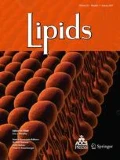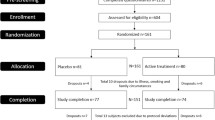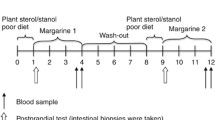Abstract
Evidence is accumulating that high serum concentrations of triacylglycerols (TAG) are, like LDL cholesterol, causally related to cardiovascular disease. A recent meta-analysis has indicated that plant stanol ester (PSE) intake not only lowered LDL cholesterol, but also serum TAG concentrations, especially in subjects with high baseline TAG concentrations. We therefore evaluated the effects of PSE supplementation on lipid metabolism in a population with elevated fasting TAG concentrations. In a randomized, placebo-controlled, parallel study, 28 subjects with elevated TAG concentrations (>1.7 mmol/L) were studied. After a 1-week run-in period during which a control margarine was used, subjects consumed for 3 weeks either control or PSE-enriched margarine (2.5 g/day of plant stanols). Serum plant stanol concentrations increased in all subjects receiving the PSE-enriched margarines, demonstrating good compliance. PSE supplementation significantly decreased serum total (6.7%, P = 0.015) and LDL cholesterol (9.5%, P = 0.041). A significant interaction between baseline TAG concentrations and PSE intake was found; PSE intake lowered TAG concentrations, particularly in subjects with high baseline TAG concentrations (>2.3 mmol/L; P = 0.009). Additionally, a significant interaction between baseline total number of LDL particles (LDL-P) and PSE intake was found (P = 0.020). PSE consumption lowered LDL-P, primarily in subjects with elevated baseline values; this was mainly due to a non-significant decrease in the number of atherogenic small LDL-P. Circulating levels of hs-CRP, glucose, and insulin were not changed after PSE intake. Taken together, PSE supplementation not only lowered LDL cholesterol, but also serum TAG concentrations, especially in subjects with overt hypertriglyceridemia.
Similar content being viewed by others
Abbreviations
- TAG:
-
Triacylglycerols
- PSE:
-
Plant stanol ester
- LDL-P:
-
LDL particles
- LDL:
-
Low-density lipoprotein
- CVD:
-
Cardiovascular disease
- HDL:
-
High-density lipoprotein
- VLDL:
-
Very-low-density lipoprotein
- sd:
-
Small dense
- DM2:
-
Type II diabetes
- FCHL:
-
Familial combined hyperlipidemia
- AZM:
-
Academic Hospital Maastricht
- GP:
-
General practitioner
- hs-CRP:
-
High-sensitivity C-reactive protein
- FFQ:
-
Food-frequency questionnaires
- TRL:
-
TAG-rich lipoproteins
- PAI-1:
-
Plasminogen activator inhibitor-1
- n.a.:
-
Not applicable
References
Malloy MJ, Kane JP (2001) A risk factor for atherosclerosis: triglyceride-rich lipoproteins. Adv Intern Med 47:111–136
Naumann E, Plat J, Kester AD, Mensink RP (2008) The baseline serum lipoprotein profile is related to plant stanol induced changes in serum lipoprotein cholesterol and triacylglycerol concentrations. J Am Coll Nutr 27:117–126
Haymore BR, Parks JR, Oliver TG, Glister BC (2005) Hypertriglyceridemia. Hospital Physician, 17–24
Syllabus behandeling en preventie van coronaire hartziekten door verlaging van de plasmaconcentratie. Utrecht: Centraal Begeleidingsorgaan voor de Intercollegiale Toetsing, 1998
Friedewald WT, Levy RI, Fredrickson DS (1972) Estimation of the concentration of low-density lipoprotein cholesterol in plasma, without use of the preparative ultracentrifuge. Clin Chem 18:499–502
Matthews DR, Hosker JP, Rudenski AS, Naylor BA, Treacher DF, Turner RC (1985) Homeostasis model assessment: insulin resistance and beta-cell function from fasting plasma glucose and insulin concentrations in man. Diabetologia 28:412–419
Plat J, Mensink RP (2001) Effects of diets enriched with two different plant stanol ester mixtures on plasma ubiquinol-10 and fat-soluble antioxidant concentrations. Metabolism 50:520–529
Shine B, de Beer FC, Pepys MB (1981) Solid phase radioimmunoassays for human C-reactive protein. Clin Chim Acta 117:13–23
Nissinen MJ, Gylling H, Miettinen TA (2008) Responses of surrogate markers of cholesterol absorption and synthesis to changes in cholesterol metabolism during various amounts of fat and cholesterol feeding among healthy men. Br J Nutr 99:370–378
Plat J, Brufau G, Dallinga-Thie GM, Dasselaar M, Mensink RP (2009) A plant stanol yogurt drink alone or combined with a low-dose statin lowers serum triacylglycerol and non-HDL cholesterol in metabolic syndrome patients. J Nutr 139:1143–1149
Havel RJ (2000) Remnant lipoproteins as therapeutic targets. Curr Opin Lipidol 11:615–620
Katan MB, Grundy SM, Jones P, Law M, Miettinen T, Paoletti R (2003) Efficacy and safety of plant stanols and sterols in the management of blood cholesterol levels. Mayo Clin Proc 78:965–978
Plat J, Nichols JA, Mensink RP (2005) Plant sterols and stanols: effects on mixed micellar composition and LXR (target gene) activation. J Lipid Res 46:2468–2476
Plat J, Mensink RP (2002) Effects of plant stanol esters on LDL receptor protein expression and on LDL receptor and HMG-CoA reductase mRNA expression in mononuclear blood cells of healthy men and women. Faseb J 16:258–260
Vuorio AF, Gylling H, Turtola H, Kontula K, Ketonen P, Miettinen TA (2000) Stanol ester margarine alone and with simvastatin lowers serum cholesterol in families with familial hypercholesterolemia caused by the FH-North Karelia mutation. Arterioscler Thromb Vasc Biol 20:500–506
Theuwissen E, Mensink RP (2007) Simultaneous intake of {beta}-glucan and plant stanol esters affects lipid metabolism in slightly hypercholesterolemic subjects. J Nutr 137:583–588
Packard CJ (2003) Triacylglycerol-rich lipoproteins and the generation of small, dense low-density lipoprotein. Biochem Soc Trans 31:1066–1069
Cohn JS, Marcoux C, Davignon J (1999) Detection, quantification, and characterization of potentially atherogenic triglyceride-rich remnant lipoproteins. Arterioscler Thromb Vasc Biol 19:2474–2486
Devaraj S, Autret BC, Jialal I (2006) Reduced-calorie orange juice beverage with plant sterols lowers C-reactive protein concentrations and improves the lipid profile in human volunteers. Am J Clin Nutr 84:756–761
Hallikainen M, Lyyra-Laitinen T, Laitinen T et al (2006) Endothelial function in hypercholesterolemic subjects: effects of plant stanol and sterol esters. Atherosclerosis 188:425–432
Relas H, Gylling H, Miettinen TA (2000) Effect of stanol ester on postabsorptive squalene and retinyl palmitate. Metabolism 49:473–478
Castro Cabezas M, de Vries JH, Van Oostrom AJ, Iestra J, van Staveren WA (2006) Effects of a stanol-enriched diet on plasma cholesterol and triglycerides in patients treated with statins. J Am Diet Assoc 106:1564–1569
Acknowledgements
We thank the study participants for their cooperation and enthusiasm. We also thank the technical and dietary staff from our department for their support. The study was supported financially by the Raisio Group Finland.
Author information
Authors and Affiliations
Corresponding author
About this article
Cite this article
Theuwissen, E., Plat, J., van der Kallen, C.J. et al. Plant Stanol Supplementation Decreases Serum Triacylglycerols in Subjects with Overt Hypertriglyceridemia. Lipids 44, 1131–1140 (2009). https://doi.org/10.1007/s11745-009-3367-6
Received:
Accepted:
Published:
Issue Date:
DOI: https://doi.org/10.1007/s11745-009-3367-6




